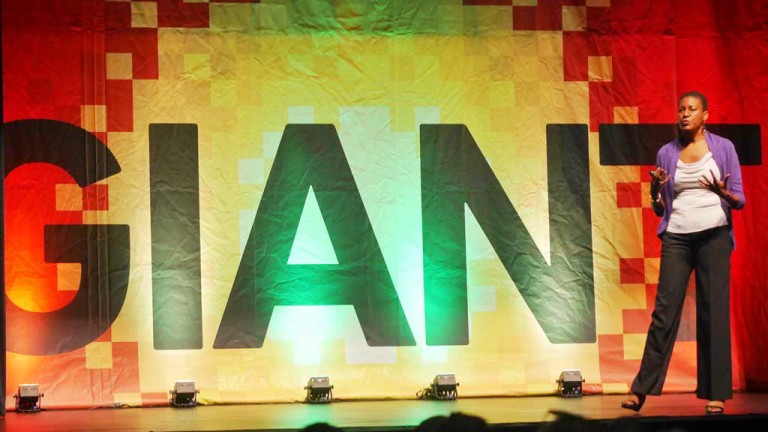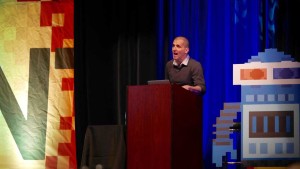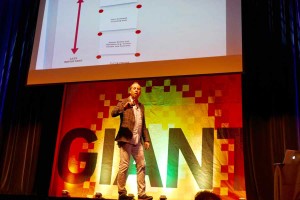Giant Conf is a design/UX conference held in Charleston, SC. It was pretty exciting to see it come out of nowhere, but still able to pull in an impressive roster of speakers in its debut year in 2014. I was there to experience it just a few months after I went to Austin for SXSW.
SXSW is an example of a conference that’s grown too big to be easily enjoyed without a ton of planning and fatigue. You have to meticulously plan out your days to make the most of it. You have to physically prepare for lots of walking around and standing in line to get into sessions. There’s also the stress of worrying that you might not get into the session you stood in line for an hour for. On average, I saw about 4 sessions a day.
With Giant on the other hand, I was able to roll into the Charleston Music Hall in the morning. Grab a free coffee and breakfast pastries, sit in the beautiful theater and listen to top draw speakers such as Aaron Draplin, Ethan Marcotte, and Jared Spool. With only 3 venues, each within a few minutes walking distance, I was able to get about 6-7 sessions a day.
Anyway…I was meaning to write about Giant last year, but life happened. One year later, I’m back at Giant Conf 2015, and this time I’m determined to get something written here. So here are my edited notes from the first 3 sessions from day one:
DISCLAIMER: These notes are from my own memory, understanding and interpretation of the content from the sessions. My note taking skills definitely deteriorated as the day went on.
You can read more session notes from day one in this post.
5 Dangerous Ideas For Designers – Scott Berkun
- The easiest way to be interesting is to be honest. If you value progress and want your team to create something truly great, then be honest with your feedback.
-
Idea #1: Everyone is a designer
- Design in the broadest sense is about finding solutions to problems/challenges
- Book recommendation: Thoughtless Acts?: Observations on Intuitive Design by Jane Fulton Suri
- Don’t be elitist when talking to clients.
- Everyone is a designer, but the vast majority are really terrible designers.
- Be an ambassador for good ideas. The word evangelist has theological origins and assumes that there is only one right answer.
-
Idea #2: You have no power
- Generally, designers don’t have power. People who have power are those who seek it.
- Designers are usually a small piece of the decision making process. True artists on the other hand are in full control of their work and don’t have to listen to anybody (edit: not sure if I totally agree with this, artists still have to please the gallery and other business entities)
- Use less jargon. The person who uses the most jargon has the least confidence in their own ideas.
- Job titles don’t mean anything. People don’t include you in meetings because of your job title, but because of the effect that you have on the process.
- Different types of power:
- Granted – power that is given to you by title
- Earned – power that is earned through your actions
- Claimed – power that is claimed because of a need e.g. designer entrepreneurs: http://designerfund.com/
-
Idea #3: Generalists are in charge
- CEOs and Presidents are generalists
- If there are 5 people in a meeting, you have less power than you think
- In-room power vs Out-of-room power: I think this is about the way decisions are made in meetings and the way people can influence those key decision makers before the meetings.
- Learn to influence the human system.
-
Idea #4: We all work in sales
- No matter who you are, or how successful you’ve been…everyone has to pitch ideas.
- Don Draper style pitching is bullshit. Charisma can’t sell bad ideas.
- Designer’s sales tools: prototyping, meetings, presentations, etc
- Learn the perspectives of people you don’t like.
-
Idea #5: Creativity is a risk
- We’ve romanticized creativity. There are plenty of myths about innovation and how we come up with new ideas: http://scottberkun.com/2013/ten-myths-of-innnovation/
- Don’t use the word ‘Innovation’. The next time you hear someone used that word, ask “What do you mean by innovation?”
- Those in power benefit from the status quo and therefore are resistant to new ideas.
- Ideas get shot down: Idea Killers: http://www.ideakillers.net/
- Inspiration only matters if behaviors change. There’s no point in being inspired by a book, speech or presentation if behaviors don’t change.
- When was the last time you were uncomfortable? That’s what creativity feels like.
Better Meetings With Co-Design – Kevin Hoffman
- We have a lot of tools to replace meetings, but the tools are not collaboration. They are part of the workflow.
- Collaboration is when the whole is greater than the sum.
- One study showed that a predictor of the success of teams was meetings. Meetings lead to collaboration.
- Co-Design is a process that involves all the stakeholders e.g. leadership, users, designers.
- Requires people to be open to ideas from anyone. Anyone can add value.
- The bigger the team meeting, the more points of agreement have to be established.
-
Always try to ask better questions:
- Proud Inquiry vs Humble Inquiry (Book by Edgar H Schein)
- Proud Inquiry
- When a questions is asked because they want to tell you something. E.g. Do you want to go ice skating? I ask because I was an Olympic figure skater.
- Asking questions with an assumption built-in. E.g. Did that experience make you feel angry?
- Humble Inquiry
- Example: How do you do?
- Put other people’s emotions before your own.
- Feeling questions: How did that make you feel? How do you feel about that? Vs Did that make you mad?
- Motivation questions: Why did you do that?
- Action questions: What did you do?
- System questions, questions about the environment and context: What resources did you have?
- MTV Case Study
- People watch live TV during award ceremony
- Two types of viewer:
- Lean-In Viewer: people who view on larger screens. Give more attention to the viewing experience.
- Lean-Back Viewer: people who casually watch, may be looking on Twitter on mobile device. Might be doing other things at the same time.
- Think about what people do before, after and during the awards ceremony. Can apply this thought to any platform where people engage.
- Discussion Architecture
- Meetings should be designed.
- What is the culture of meetings within your company?
- Navigating conflict is part of the job. Conflict will always arise, so it’s best to deal with it head on in meetings.
- Get to a decision point in meetings.
Practical techniques for Field Research – Brad Nunnally
- Technology will fail you. Make sure your test subject is comfortable using tools such as WebEx before the session.
- Take travel time into account.
- Small talk matters. It helps build a connection with the interviewee.
- When you’re interviewing someone, you’re in control. – Barbara Walters
- Keep energy levels consistently high throughout out the day. Take breaks to recharge your batteries.
- Your curiosity and sense of wonder is your greatest weapon as a researcher.


